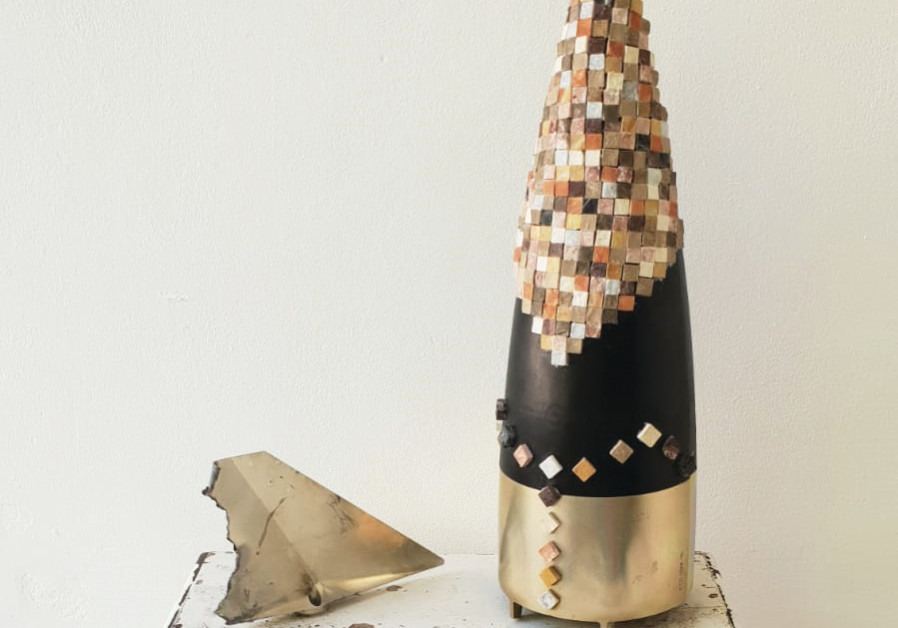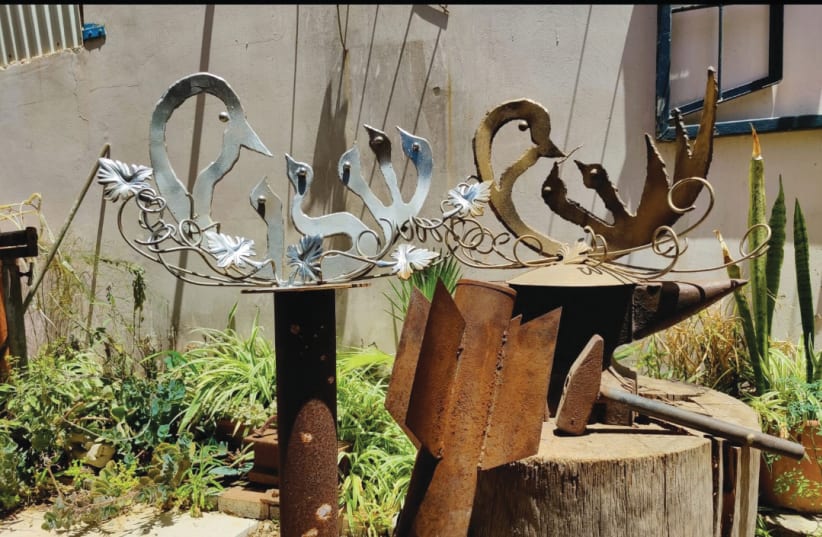During Operation Guardian of the Walls, more than 4,360 rockets were fired at Israel from the Gaza Strip. Over 1,660 of them were intercepted by Iron Dome and over 1,820 rockets fell in open areas. A few people, however, have a different attitude toward these weapons.
They are collecting fragments of rockets that were intercepted or exploded upon hitting the ground, and turning them into works of art.
One such individual is Avi Tzafon from Hadera. Tzafon, an Magen David Adom paramedic for the past 35 years, has been dabbling in sculpting since he was 12. He’s created over 200 sculptures made with fragments and remains of mortars, Katyusha rockets and missiles. “I absolutely love bringing these types of creations to life,” explains Tzafon. “After each operation in the Gaza Strip has ended, I hop in my car and hunt for pieces of rockets to add to my collection. I find mortars, shells and Katyushas, and then make environmental sculptures out of them.”
Do you recall the first sculpture that you made?
“Of course! It was in 2008 after Operation Cast Lead, and I found my first piece of a rocket that had landed near Tel Aviv. I remember it so clearly because it had on it the name of the person who had fired it. I realized right away that I wanted to make a sculpture with it and with other remnants I could find.
“My hope is that one day Israel will reach a peace arrangement with the guys in Gaza, we will be able to hold a joint exhibition: They shot these mortars at us, so we could give them my sculptures in return. Each one is unique. When you look at them, it’s easy to ascertain which kind of weapon they came from.”
Tzafon plans to make some new sculptures from fragments he collected following the most recent operation Guardian of the Walls. “I saw one mortar that fell crookedly, and I’ve been thinking I could turn it into a couple of lovers, as a symbol of peace and love,” Tzafon explains. “I think people on the Israeli side as well as the people on the other side of the border are thirsty for love and could use some hugs. So that’s my plan for this mortar shell, and I really hope I can display it in an exhibition one day.”
Ami Apter of Ashdod, who works at Intel, is another amateur artist who collects rocket fragments and creates works of art from them. Apter, however, was introduced to this hobby accidentally one day while out walking his dog. “I had just left the house with my dog,” Apter recounts, “and right away I came across a bunch of pieces of shrapnel, so I decided to make something with them. It’s a natural wonder – the Iron Dome exploded the rocket, and I’m making works of art from the remnants.”
Did you create anything from pieces left over from the most recent round of violence?
“Yes, I felt very strongly that I should create a work of art that shouts out: ‘The people of Israel live!’ So I made a Star of David and I plan on adding a light fixture to it, which will make it look even more impressive.”

Do you go out on hunting expeditions to find rocket fragments?
“No, I just pick up pieces if I happen to come across them. But I do make a sculpture out of every piece I find. I live in Ashdod, though, so pretty much everywhere I go I find pieces around, since so many rockets exploded right above us. In fact, I already have ideas running around in my head for sculptures I’ll make in the future when I find more rocket fragments.”
Einav Nomi Karmi and Avi Mana from Kibbutz Nir Am began collecting rocket fragments in 2017. “At first, we did it as an act of provocation,” Karmi says. “We had the courage to start collecting bits and pieces of rocket fragments despite the danger involved. We uploaded photos of them to Facebook Stories as a provocation against the provocations carried out by the Arabs.
“But then, as part of my architecture degree, I was required to come up with an idea for a project, so I designed a chair from rocket fragments. I got help from Avi, who I know from the kibbutz, and our chair even won a prize! Now the chair is sitting in my parents’ garden.”
“I’ve been into sculpting since I was a kid on the kibbutz and we lived in the Children’s House,” remembers Mana. “But I hadn’t really made anything lately until Einav asked me to help her on her architecture project. We actually began gathering these pieces so we could get them out of reach of the kids so they wouldn’t get hurt. And that’s how the idea for creating a chair from them arose. Of course, we consulted the kibbutz’s head of security before starting.”
Have you designed anything else since then?
“Yes. I took two pieces of missile fragments that had been exploded by the Iron Dome and I made a mosaic with them. I’ve been searching for more shards, and I’ve got a few ideas for what to do with them. Einav and I are already planning our next project.”
Aren’t you afraid to touch rocket fragments?
“Most of the pieces we collect are just small pieces of metal, without any explosives on them. They’re just covered in soot. Once, we found an entire missile that was hollow like a pipe that I guess hadn’t exploded. We didn’t think too much about it at the time. We saw one fall. We waited to see if there was anything dangerous, then we picked it up.”
“I just recently found some fragments from Grad rockets. I might make something with them,” says Ronen Horev from Ma’agalim in the Sdot Negev Regional Council. “I’ve really been into creating Judaica since I was a kid. I grew up in a religious home, and going to pray in the synagogue and engaging in Jewish rituals was a big part of my life. When I was 12, I had a hard time learning – I used to disrupt the class a lot, so my teachers would often kick me out of the classroom. So I would just walk home, and I began spending my time carving mezuzot. I’ve been running my business, Ron Art Judaica, for over 40 years now. I make all sorts of Judaica objects to order.”
During Operation Protective Edge in 2014, Horev began making mezuzot out of Grad rocket shrapnel. “We were hit pretty hard with rocket showers, so I began collecting fragments since I was curious what kind of material they were made from,” Horev continues. “I wouldn’t take bullet casings, just shards. I began integrating these pieces into my products, and I discovered that the materials were extremely hard and challenging to work with. I got hooked, and now I use rocket fragments all the time. At one point I ran out of pieces, so I posted on Facebook asking if anyone had pieces they could give me, and lots of friends started bringing me pieces of Grad rockets so I could use them in my designs.”
Did you collect any pieces following the recent round of violence?
“I got calls from a few friends in Sderot who know I’m always searching for more materials. They gave me some fragments and mortar shells. I’ve got great friends,” Horev adds with a big smile.
Inbal Duvdevani from Kibbutz Nirim, who has owned a jewelry design studio for over a decade, began integrating pieces of rockets into her jewelry after Operation Protective Edge. “Lots of rockets fell in the kibbutz, so we were evacuated to Kibbutz Mishmar Haemek and had to stay away from home for six weeks,” Duvdevani recalls. “Just after the first ceasefire was declared and we had gone back home, a mortar fell just in front of my studio. My studio didn’t sustain too much damage, fortunately, but my kids’ new hobby was to wander around the kibbutz searching for and gathering fragments from rockets. It was a very stressful time overall, since two of our friends [Ze’evik Etzion and Shahar Melamed] were killed, and at first I couldn’t touch these pieces of rockets. Not because I was afraid they’d blow up, but because they were part of rockets that had killed my friends.”
After the war ended, Duvdevani flew to the US with mezuzot she’d made using rocket fragments to show to customers. “People had expressed interest in buying things made with rocket fragments, so I decided to take advantage of this trend and incorporate them in my crafts,” Duvdevani continues. “I also made a few 14-karat gold necklaces with pieces of shrapnel, and I’ve sold them all over the world. My collection of fragments has recently been upgraded following the recent round of violence. Unfortunately, there are too many pieces of rockets available for me to use in my artwork.”
Duvdevani’s jewelry and Horev’s mezuzot are currently being featured in an online campaign aimed at encouraging people to purchase items from local artists in the western and northern Negev in an effort to help bolster their businesses, which were harmed due to the recent violence.
Translated by Hannah Hochner.
